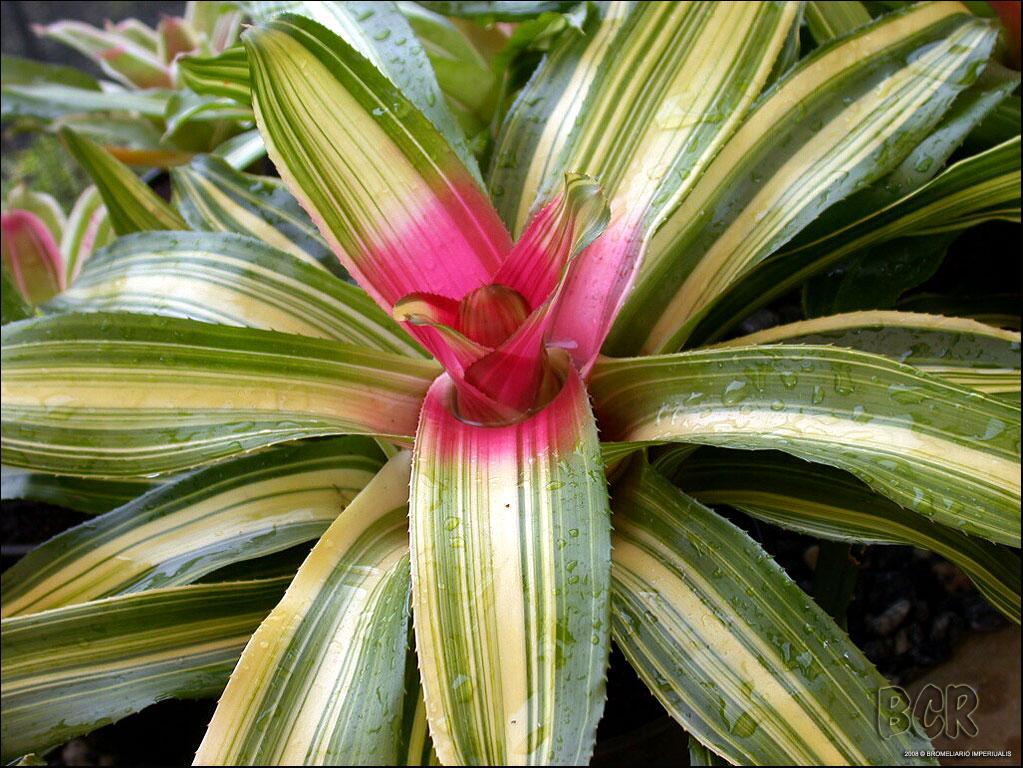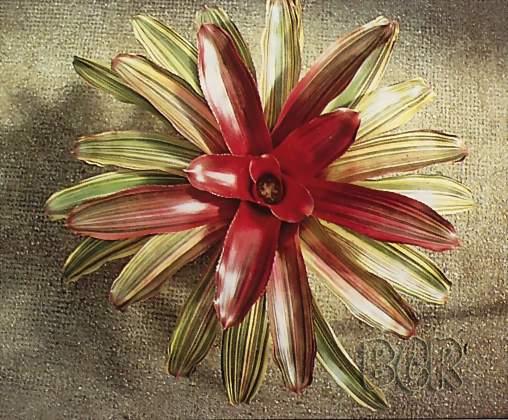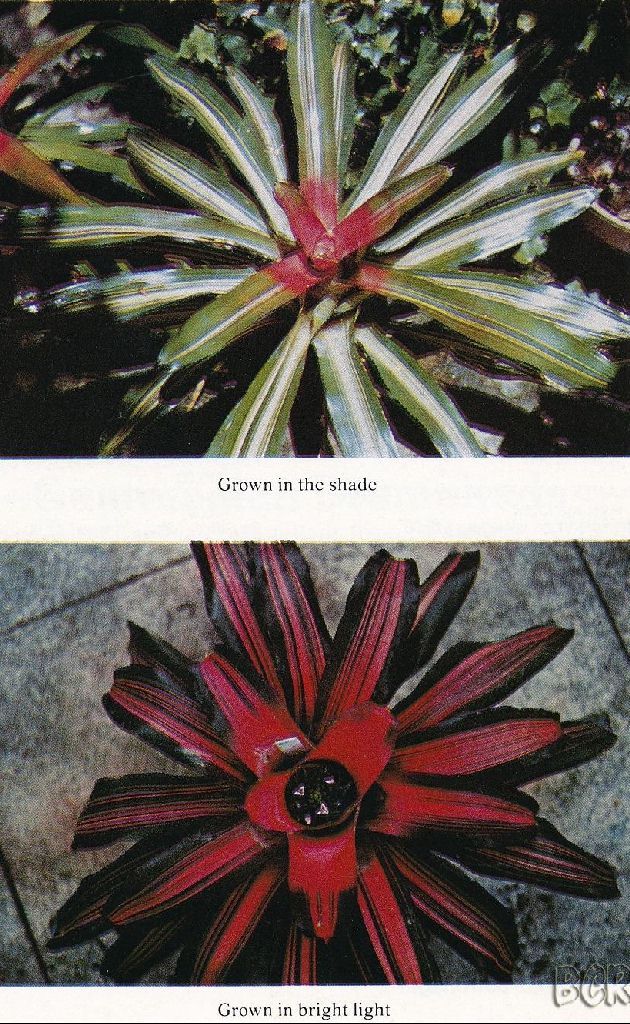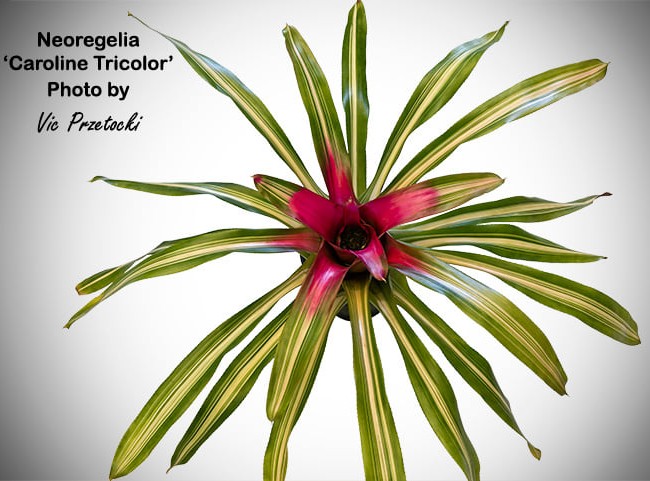



Protologue
NEOREGELIA CAROLINAE var. TRICOLOR M. B. Foster var. nov. Bromel. Soc. Bull. 3: 29. 1953.
A var. carolinae foliis rubro albo virideque longitudinaliter pictis differt.
Cultivated in Orlando, Florida, since 1944. M. B. Foster No. 2831 (Type in U. S. National Herbarium).
This striking three-colored variety of Neoregelia carolinae has been known for several years both in Europe and America but has invariably been listed by horticulturists and sold as Nidularium tricolor. The writer has collected two different phases of the typical Neoregelia carolinae both in their native habitat in Brazil, and examination of this new variety tricolor show it to be definitely a variegated form of the species carolinae.
The leaves of Neoregelia carolinae var. tricolor are distinctly striped in white, rose and green, a striking contrast to the plain green leaves of the typical Neorcgelia carolinae, while the center scape bracts surrounding the flower head are of the usual deep red, the same as in the typical Neoregelia carolinae.
This variegated form does not come true from seed, therefore, must be propagated by offshoots to continue its variegated coloration. Even then, one may occasionally find a perfectly green offshoot just as seedlings would be.
Neoregelia carolinae (Beer) L. B. Smith forma tricolor (M. B. Foster) M. B. Foster ex L. B. Smith, Phytologia 15: 186. 1967.
Neoregelia carolinae var tricolor M. B. Foster, Bromel. Soc. Bull. 3: 29. 1953.
Leaf-blades longitudinally striped white, rose and green.
Type. Foster 2831 (holotype US), cultivar in Florida since 1944, collected Dec 1953.
Distribution. Known only in cultivation.
SOME CHOICE CLONES OF NEOREGELIA CAROLINAE by ERVIN WURTHMANN AND WILLIAM DRYSDALE in Bromel Soc Bull 16(6): 131. 1966
NEOREGELIA CAROLINAE VAR. TRICOLOR - This bromeliad of unusual beauty is gaining in popularity among plant fanciers in this country. In Europe where bromeliads were in vogue for many years before they were introduced into the United States, Neoregelia carolinae var. tricolor is still one of the top sellers. (See Bulletin,Vol. VIII, P. 71.)
There is considerable difference in the three types being offered on the market; this difference can probably be accounted for by the fact that Neoregelia carolinae sported at three different nurseries on the Continent. The most striking form is compact, many leaved, and has pink coloration suffused through its entire foliage even as a young plant, provided good light is furnished. Upon flowering, the center leaves turn a cherry red; this coloring persists for many months, sometimes upwards of a year.
The other extreme is fewer leaved, the leaves also being more straplike in appearance. Only upon flowering when the center leaves take on their color do the center leaf areas show any indication of pink suffusion, which tends to leach out after flowering has ceased.
The intermediate type, while more compact than the latter, is just as reluctant to acquire the pink coloration in the outer leaves when immature.
Only when grown in bright light (50% constantly filtered or nearly so) can the true potential coloration and conformation be attained. With less favorable light, the pink blush in the foliage of the more compact, more highly colored type will diminish or disappear, but the difference is still quite apparent, making the other types scraggly by comparison.
The Origins of Three Variegated Neoregelia carolinae Clones by Michael P McMahon in J Brom Soc 35(5): 197-199, 205. 1985
Thirty-two years ago Mulford Foster described Neoregelia carolinae var. tricolor as a new variety in the Bromeliad Society Bulletin of July-August 1953. He noted that this plant "has been known for several years both in Europe and America but has invariably been listed by horticulturists and sold as Nidularium tricolor." He also observed that it does not come true from seed, and therefore must be propagated by offshoots to retain the variegation.
Most growers believe the origin of this popular plant to be forever lost in the mystery of the past. In this article I hope to share what I have learned of the origin of variety tricolor.
My bromeliad hobby and profession as an attorney came together when I was retained by the noted Belgian grower, Paul deCoster, and the Homestead, Florida, firm of Trans Florida Foliage to prosecute a patent infringement case. Mr. deCoster owns the U. S. plant patent for Neoregelia carolinae 'Perfecta Tricolor', and Trans Florida Foliage is his prime licensee. The legal issue was whether N. carolinae 'Perfecta Tricolor' is patentably distinguishable from N. carolinae forma tricolor. To assist the prosecution of the case, an examination of the origins of these plants was necessary.
The information in this article is taken primarily from the official records of Belgian horticultural review boards and sworn statements filed in the official records of the U. S. Patent and Trademark Office by those personally familiar with the origins of these plants, including Omer Morobe. Perhaps the most interesting discovery to bromeliophiles is that two different plants are to be found in commerce bearing the name N. carolinae var. tricolor.
In 1929 Arthur Gyselinck was raising seedlings of the common N. carolinae "Meyendorfii" (then known as Nidularium meyendorfii) at his family's nursery, M. L. Gyselinck, fils. Among the seedlings he found a single variegated sport, which he isolated and nurtured. This distinctively beautiful plant was displayed before the prestigious Belgian horticultural societies in 1932 under the name Nidularium Regelia foliis medio Aurea stiata. It was then recognized as a new plant variety in the official proceedings of the meetings of the societies. The Gyselinck clone was soon being cultivated in the family business. Over the ensuing years, it was sold under several names, including Nidularium meyendorfi 'Folis Variegatis.'
Eventually it became known in the trade as N. carolinae var. tricolor.
Just three years after the Gyselinck clone had bloomed for the first time, Omer Morobe discovered an entirely separate form of variegated N. carolinae. This is the man for whom many outstanding bromeliad hybrids and cultivars have been named. He was employed in 1935 by the firm of M. A. Declerq-van Ghysegem. In the course of raising seedlings of N. carolinae 'Marechalii' (then known as Nidularium marechalii), he found a variegated mutation, which became named Nidularium marechalii tricolor. In 1937, the Declerq clone was recognized by the Belgian horticultural societies as a new variety, and honored by the award of a certificate of merit. The following year it was awarded a medal at the Floralie of 1938 at Ghent. Mr. Morobe later married the daughter of Mr. Declerq-van Ghysegem, established his own nursery and began growing the Declerq clone as a major crop. Over the years, the Declerq clone also became known in the trade as N. carolinae var. tricolor.
These plants initially were known by distinctive, albeit incorrect names. They should have retained different names for botanical nomenclature purposes. At the same time, it has not been determined which of the two clones Mulford Foster had in mind when he published his description. On the one hand, given the fact that the Declerq clone was produced in greater numbers, and that Mr. Foster referred to his plant as being known in Europe by the synonym Nidularium tricolor, it would seem likely that he had obtained Mr. Morobe's Nidularium marechalii tricolor. On the other hand, in my own plant collection N. carolinae var. tricolor is the Gyselinck clone (as established by careful comparison). Since many of my old favorites, like tricolor, were obtained from Orlando area old-timers, who in turn were the direct beneficiaries of Mr. Foster's generosity, it seems equally possible that Mr. Foster possessed the Gyselinck clone. Racine Foster has sifted through much of Mr. Foster's voluminous correspondence in search of the answer, but to no avail. The herbarium specimen of Mr. Foster's type N. carolinae forma tricolor (M. B. Foster 2831), U. S. National Herbarium, may eventually provide an answer. The differences between the two clones are so slight, however, that they may well be indistinguishable when dried and pressed specimens are compared. Examination of a high quality photocopy of the type generously provided by Dr. Robert W. Read, did not disclose to this writer which clone Mr. Foster described.
The distinctions between the two clones are subtle, but discernible. Although several differences have been noted by their growers, I have observed three to be consistent. First, the Gyselinck clone develops a rosy-red center with a tinge of orange when flowering. The Declerq clone's center becomes a deep red. Second, the creamy striping of the Gyselinck clone is usually very slightly broader than that of the Declerq clone. This difference is not apparent on casual observation, but is a distinction Omer Morobe described in U. S. Patent Office proceedings as being consistent. The visual effect of the slightly wider striping is noticed when both clones are viewed together from a distance or when two leaves are viewed close-up. Third, in the Gyselinck clone the flower bracts tend to remain below the elevation of the leaves, while in the Declerq clone the bracts tend to rise slightly above the elevation of the leaves, as is generally true of the 'Marechalii' cultivar of N. carolinae.
A third variegated N. carolinae cultivar was discovered in 1968 by Adriens Simoens of Merelbeke, Belgium. It was named 'Perfecta Tricolor' by Paul deCoster. It is interesting to note that this third cultivar, like the Declerq clone, was also found among N. carolinae 'Marechalii' seedlings. The broad leaves and compact growth habit of 'Perfecta Tricolor', however, make it decidedly more attractive and desirable. On the basis of these differences, 'Perfecta Tricolor' was granted a Belgian plant patent in 1975 and a U. S. plant patent in 1976. (Mr. Simoens has since transferred his patent rights to Mr. deCoster, who has been responsible for its commercial development.)
In 1985 the U. S. Patent and Trademark Office completed a re-examination of the 'Perfecta Tricolor' patent and upheld it as valid. As a result, it is clear that it is unlawful in the United States to reproduce 'Perfecta Tricolor' asexually (i.e., to remove pups) for sale without authorization from Mr. deCoster and Trans Florida Foliage, Mr. deCoster's U. S. licensee. All lawfully grown or imported plants are tagged with labels stating that they are patented. Unlawfully grown plants are subject to seizure and destruction under U. S. patent laws, and their growers could be held liable in court for infringement.
As far as I am aware, these are the only established clones of N. carolinae with central stripes of variegation. The highly variable specimens of N. carolinae generally sold under the varietal misnomer meyendorfii variegata are all marginated, and have thick, coarse leaves. (Perhaps someone will undertake to study the origins of these marginated plants.) It would seem that other sports must have occurred over the years, but either have been ignored or have not been established as cultivars. If so, it is unfortunate because some beautiful strains have surely been lost. Indeed, it appears that over the next few decades the Gyselinck and Declerq clones may also be lost. In Europe, 'Perfecta Tricolor' has become the commercial plant of choice, with even the Morobe family nursery discontinuing its own Declerq variety in favor of 'Perfecta Tricolor'. In the United States, this trend is just beginning, but in many areas the old clones now can be found only occasionally in a collector's greenhouse, with retailers appearing to have opted for the showier and more compact 'Perfecta Tricolor'. In many ways, it is a matter of survival of the fittest, but the impending loss is a bit sad especially now that I feel an affinity to all of these treasures.
NOTES:
1. The category variety was later changed to forma: N. carolinae forma tricolor (L.B. Smith, Bromelioideae {New York: N. Y. Botanical Garden, 1979}; 1553).
2. In re: U. S. Plant Patent 3,971: Re-examination Request Control No. 000,557.
3. This name was chosen by Mr. Gyselinck as descriptive of his discovery. It has never been recognized as botanically correct.
4. Labels are available from Trans Florida Foliage, 24500 S.W. 167th Avenue, Homestead, Florida 33031, upon payment of standard royalties of $0.20 (U.S.) per plant. Other licensees and sublicensees in the United States are prohibited from selling labels separate from plants.
The Belgians and the Bromeliads by G Samyn & E Thomas in J Brom Soc 46(1): 11-15. 1996
A selected paragraph:
There are six bromeliad growers in Belgium located around Ghent near the Research Station of Ornamental Plant Growing who are active breeders. They are: Albert Deroose, succeeded by his son Reginald, Hendrik De Meyer, Caroline De Meyer and her husband Luc Pieters, and Luc Devroe who specializes in Neoregelia and Nidularium. We wrote in some detail recently (Samyn 1995) about the activities of De Meyer, Deroose, and Pieters-De Meyer, and for that reason will not repeat ourselves. Devroe deserves mention for his culture of chimeric classics such as Neoregelia 'Perfecta Tricolor' , and N. 'Flandria' , and several selected mutants such as N. 'Devroe', and N. 'Gruvroe'. He is now collaborating with this Research Station in the development of different, small, commercial Neoregelia types: the ‘Cathy’ clones.